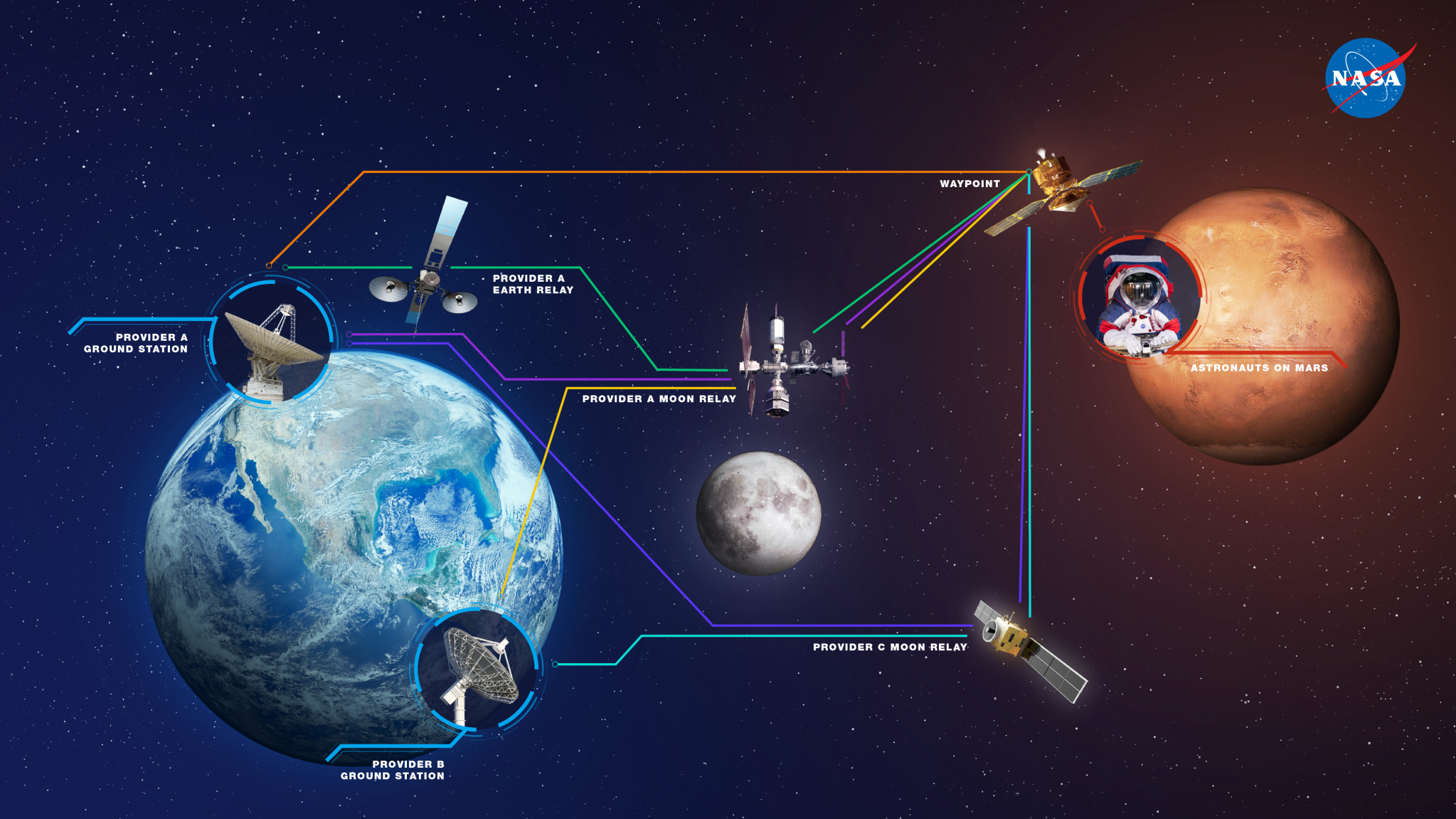What is DTN?
Delay/Disruption Tolerant Networking (DTN) is a suite of standard protocols that use information within the data stream (headers attached to data units) to accomplish end-to-end data delivery through network nodes. DTN enables data delivery in situations that involve
- Disconnections (e.g., end-to-end link unavailability)
- Delays (e.g., Deep Space missions)
- Data rate mismatches (e.g., high data rate Science downlinks but lower rate terrestrial connections)
A DTN architecture is a store-and-forward communications architecture in which source nodes send DTN bundles through a network to destination nodes.
How Does DTN Work?
The DTN protocol suite can operate in tandem with the terrestrial IP suite or it can operate independently. DTN provides assured delivery of data using automatic store-and-forward mechanisms. Each data packet that is received is forwarded immediately if possible, but stored for future transmission if forwarding is not currently possible but is expected to be possible in the future. As a result, only the next hop needs to be available when using DTN.
The DTN suite also contains network management, security, routing and quality-of-service capabilities, which are similar to the capabilities provided by the terrestrial Internet suite.
- Improved Operations and Situational Awareness: The DTN store-and-forward mechanism along with automatic retransmission provides more insight into events during communication outages that occur as result of relay or ground station handovers and poor atmospheric conditions, and significantly reduces the need to schedule ground stations to send or receive data, which can sometimes require up to five days of planning before a transmission takes place.
- Interoperability and Reuse: A standardized DTN protocol suite enables interoperability of ground stations and spacecraft operated by any space agency or private entity with space assets. It also allows NASA to use the same communication protocols for future missions (low-Earth orbit, near-Earth orbit or deep space).
- Space Link Efficiency, Utilization and Robustness: DTN enables more reliable and efficient data transmissions resulting in more usable bandwidth. DTN also improves link reliability by having multiple network paths and assets for potential communication hops.
- Security: The DTN Bundle Protocol Security allows for integrity checks, authentication and encryption, even on links where not previously used.
- Quality-of-Service: The DTN protocol suite allows for many priority levels to be set for different data types, ensuring that the most important data is received ahead of less important data.
Why Develop DTN?
DTN provides a general-purpose network-/transport-layer service that is logically similar to what TCP/IP provides for the terrestrial Internet, but suitable for use in the space environment. In addition to the basic store-and-forward internetworking service, DTN also provides: efficient reliability; security; in-order delivery; duplicate suppression; class of service (prioritization); remote management; a ‘DVR-like’ streaming service, rate buffering, and data accounting, all over possibly asymmetric and time-disjoint paths. Multiple applications including file transfer, messaging (e.g. for mission operations), and streaming audio/video can all be implemented on top of DTN and leverage its services to reduce risk, cost, and complexity.
The Consultative Committee for Space Data Systems (CCSDS) has other specifications that individually implement some aspects of the network and transport-layer services that DTN provides, but none of them provide the flexibility or automated data transfer that DTN does. For example:
- Space Packet Protocol: The space packet protocol supports a path addressing capability – essentially the ability to forward packets across a managed end-to-end data path through the network – but this capability has never been implemented in a space system. No provisions are made for addressing the scheduled nature of connectivity, nor does the space packet protocol support any of the DTN capabilities listed above (beyond a simple unreliable data transport).
- CCSDS File Delivery Protocol (CFDP): CFDP is a file transfer protocol that provides reliable delivery of files, and includes its own optional application-layer store-and-forward mechanisms. These store-and-forward operations form the basis for the DTN reliable data transfer mechanisms, but CFDP itself only supports file transfers (not messaging, streaming, or other applications).
How Is NASA Infusing DTN across Its Communications Networks?
The Space Communications and Navigation (SCaN) program is using a three-phased approach to deploy DTN-enabled operational communications support across the SCaN Network. Its Initial Operating Capability (IOC) is expected in 2021, to support the upcoming DTN users PACE (via the NSN) and KPLO (via the DSN).
DTN Myths and Facts
Myth: DTN increases the speed of data delivery on an individual link
Fact: DTN may reduce end-to-end latency by allowing more efficient use of available links
Myth: DTN requires additional link hardware because all missions will be required to be relay nodes
Fact: DTN does not require all missions to be relay nodes
Myth: DTN changes how radio frequency (RF) links are scheduled
Fact: Links still need to be pre-established
Myth: DTN is only of value for Deep Space missions
Fact: Many mission types benefit from reuse, standardization, and networking provided by DTN
Myth: DTN requires the addition of intermediate nodes to a mission’s data delivery architecture
Fact: DTN does not mandate the use of intermediate nodes
Myth: All missions have the same data delivery requirements
Fact: Mission science is not always severely impacted by loss of data
Fact: Onboard storage is becoming less of a cost driver

























